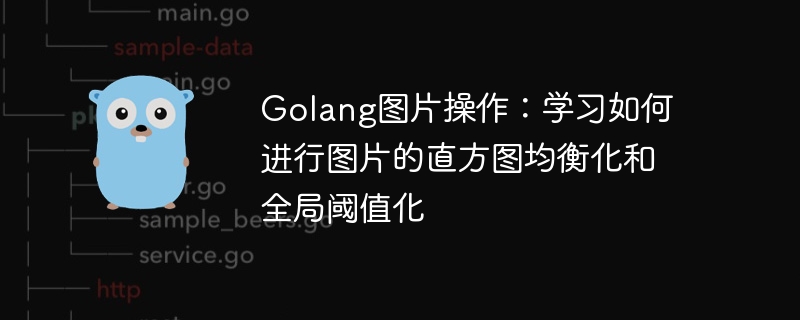Golang圖片操作:學習如何進行圖片的直方圖均衡化和全域閾值化
- 王林原創
- 2023-08-18 14:49:52830瀏覽

Golang圖片操作:學習如何進行圖片的直方圖均衡化和全局閾值化
引言:
圖片處理是電腦視覺和圖像處理領域中的重要任務之一。在實際應用中,我們常常需要進行一些影像增強操作,以提高影像的品質或突顯影像中的某些特徵。本文將介紹如何使用Golang進行影像的直方圖均衡化和全域閾值化操作,以實現影像增強的目的。
一、直方圖均衡化
直方圖均衡化是一種常用的影像增強方法,它透過對影像像素的灰階分佈進行調整,使得影像的對比度得到增強。在這種方法中,我們首先計算影像的累積直方圖,然後根據累積直方圖對影像進行像素值的調整。
下面是一個簡單的Golang程式碼範例,用於實現圖像的直方圖均衡化:
package main
import (
"fmt"
"image"
"image/color"
"image/jpeg"
"os"
)
func main() {
// 打开图片文件
file, err := os.Open("input.jpg")
if err != nil {
fmt.Println(err)
return
}
defer file.Close()
// 解码图片
img, _, err := image.Decode(file)
if err != nil {
fmt.Println(err)
return
}
// 计算直方图
hist := histogram(img)
// 计算累积直方图
cumHist := cumulativeHistogram(hist)
// 根据累积直方图对图像进行像素值调整
newImg := adjustPixels(img, cumHist)
// 保存处理后的图像
outFile, err := os.Create("output.jpg")
if err != nil {
fmt.Println(err)
return
}
defer outFile.Close()
// 编码图像
err = jpeg.Encode(outFile, newImg, &jpeg.Options{Quality: 100})
if err != nil {
fmt.Println(err)
return
}
fmt.Println("图像处理完成!")
}
// 计算直方图
func histogram(img image.Image) []int {
bounds := img.Bounds()
w, h := bounds.Max.X, bounds.Max.Y
hist := make([]int, 256)
for y := 0; y < h; y++ {
for x := 0; x < w; x++ {
r, _, _, _ := img.At(x, y).RGBA()
gray := color.Gray{uint8(r / 256)}
hist[gray.Y]++
}
}
return hist
}
// 计算累积直方图
func cumulativeHistogram(hist []int) []int {
cumHist := make([]int, len(hist))
cumHist[0] = hist[0]
for i := 1; i < len(hist); i++ {
cumHist[i] = cumHist[i-1] + hist[i]
}
return cumHist
}
// 根据累积直方图调整像素值
func adjustPixels(img image.Image, cumHist []int) image.Image {
bounds := img.Bounds()
w, h := bounds.Max.X, bounds.Max.Y
newImg := image.NewRGBA(bounds)
for y := 0; y < h; y++ {
for x := 0; x < w; x++ {
r, g, b, a := img.At(x, y).RGBA()
gray := color.Gray{uint8(r / 256)}
val := uint8(float64(cumHist[gray.Y]) / float64(w*h) * 255)
newImg.Set(x, y, color.RGBA{val, val, val, uint8(a / 256)})
}
}
return newImg
}在上述程式碼中,我們首先透過image套件的Decode函數將輸入影像檔案解碼為image.Image類型的物件。然後,我們分別呼叫histogram函數計算圖像的直方圖,cumulativeHistogram函數計算圖像的累積直方圖。最後,我們根據累積直方圖調整影像的像素值,並使用jpeg#包的Encode函數將處理後的影像儲存到檔案中。
二、全域閾值化
全域閾值化是一種簡單但有效的影像二值化方法,它將影像的像素值分為兩個互不重疊的光滑區域,分別代表目標物件和背景。這種方法通常應用於具有明顯的前景和背景差異的影像。
下面是一個簡單的Golang程式碼範例,用於實現圖像的全域閾值化:
package main
import (
"fmt"
"image"
"image/color"
"image/jpeg"
"os"
)
func main() {
// 打开图片文件
file, err := os.Open("input.jpg")
if err != nil {
fmt.Println(err)
return
}
defer file.Close()
// 解码图片
img, _, err := image.Decode(file)
if err != nil {
fmt.Println(err)
return
}
// 根据全局阈值对图像进行二值化处理
newImg := binarize(img)
// 保存处理后的图像
outFile, err := os.Create("output.jpg")
if err != nil {
fmt.Println(err)
return
}
defer outFile.Close()
// 编码图像
err = jpeg.Encode(outFile, newImg, &jpeg.Options{Quality: 100})
if err != nil {
fmt.Println(err)
return
}
fmt.Println("图像处理完成!")
}
// 根据全局阈值对图像进行二值化处理
func binarize(img image.Image) image.Image {
bounds := img.Bounds()
w, h := bounds.Max.X, bounds.Max.Y
newImg := image.NewRGBA(bounds)
threshold := calculateThreshold(img)
for y := 0; y < h; y++ {
for x := 0; x < w; x++ {
r, g, b, a := img.At(x, y).RGBA()
gray := color.Gray{uint8(r / 256)}
var val uint8
if gray.Y > threshold {
val = 255
} else {
val = 0
}
newImg.Set(x, y, color.RGBA{val, val, val, uint8(a / 256)})
}
}
return newImg
}
// 根据图像的直方图计算全局阈值
func calculateThreshold(img image.Image) uint8 {
hist := histogram(img)
totalPixels := img.Bounds().Max.X * img.Bounds().Max.Y
// 计算背景像素值的总和
var bgSum, bgCount, fgSum, fgCount int
for i := 0; i < len(hist); i++ {
if i <= 128 {
bgSum += i * hist[i]
bgCount += hist[i]
} else {
fgSum += i * hist[i]
fgCount += hist[i]
}
}
// 计算背景和前景的平均灰度值
bgMean := bgSum / bgCount
fgMean := fgSum / fgCount
// 根据背景和前景的平均灰度值计算阈值
return uint8((bgMean + fgMean) / 2)
}
// 计算直方图
func histogram(img image.Image) []int {
bounds := img.Bounds()
w, h := bounds.Max.X, bounds.Max.Y
hist := make([]int, 256)
for y := 0; y < h; y++ {
for x := 0; x < w; x++ {
r, _, _, _ := img.At(x, y).RGBA()
gray := color.Gray{uint8(r / 256)}
hist[gray.Y]++
}
}
return hist
}在上述程式碼中,我們首先透過image套件的Decode函數將輸入影像檔案解碼為image.Image類型的物件。然後,我們呼叫calculateThreshold函數計算影像的全域閾值。最後,我們根據全域閾值將影像進行二值化處理,並使用jpeg包的Encode函數將處理後的影像儲存到檔案中。
總結:
本文我們介紹如何使用Golang進行影像的直方圖均衡化和全域閾值化運算。直方圖均衡化可用於提高影像的對比度,使影像更加清晰和鮮明;全域閾值化可用於將影像轉換為二值影像,突出影像中的目標物件。透過靈活運用這兩種方法,我們可以實現對影像的增強和特徵提取,滿足各種應用需求。在實際應用中,我們可以結合其他影像處理演算法,進一步提升影像處理的效果和品質。
以上是Golang圖片操作:學習如何進行圖片的直方圖均衡化和全域閾值化的詳細內容。更多資訊請關注PHP中文網其他相關文章!

